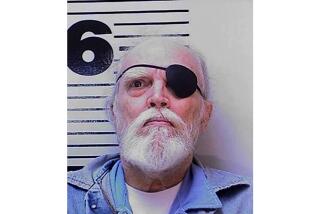Jury Finds Man Guilty of Murders : Court: Defense argument that Douglas Frederick Stanley suffered amnesia fails. His sister-in-law and a co-worker were gunned down at a Fountain Valley embroidery shop.
- Share via
SANTA ANA — A Superior Court jury convicted a Westminster man of two counts of first-degree murder Tuesday, rejecting arguments that because he suffered a form of amnesia he could not have planned to kill his sister-in-law and another woman.
*
The announcement of the verdict against Douglas Frederick Stanley brought tears and cries of relief in the courtroom from the family and friends of victims Joyce Stanley and Terry Vasquez. The women were gunned down July 8, 1993, at a Fountain Valley embroidery shop owned by Joyce and Charles Stanley, the defendant’s brother.
Outside the courtroom, family members shared hugs and tears with jurors, thanking them for their work.
“We are just happy that (jury members) were hearing the truth,” said Pamela Harrington, the daughter of Joyce Stanley.
“Our prayers were answered,” added Jan Watson, Joyce Stanley’s sister. “We all know it was premeditated. For anything less . . . it wouldn’t have been justice.”
Douglas Stanley, 58, faces life in prison without the possibility of parole when he is sentenced Nov. 4 by Judge David O. Carter. The jury deliberated less than five hours last week before finding the former ranch hand guilty of two counts of first-degree murder with a special-circumstance allegation of multiple murder. Several jurors declined to answer a reporter’s questions about the case.
Prosecutors had decided before the trial not to seek the death penalty against Douglas Stanley.
The jury also found Douglas Stanley guilty of using a firearm and stealing his sister-in-law’s car, in which he fled to Colorado following the shootings, sparking a nationwide manhunt. He was captured July 11, after a gun fell out of one of his pants legs while he was being questioned by a Colorado state trooper at a roadside stop.
The jury reached the verdict Friday, but it was sealed until Tuesday morning, when attorneys in the case were available.
Prosecutor Robert Molko contended during the 15-day trial that Douglas Stanley plotted the killing because of longstanding grudges he held against Joyce Stanley, 52, and Vasquez, 41. Douglas Stanley, who worked with both women, blamed his sister-in-law for his estrangement from his daughter and did not like having the two women as his supervisors at the business, Molko said.
Douglas Stanley also boasted to a friend shortly before the killings that he was finally about to get his revenge. He withdrew a large sum of money from his own bank account, Molko said during the trial.
But Joyce Stanley had nursed the defendant back to health after he had heart bypass surgery about a year before the killing and was constantly urging him to take care of himself, Molko said.
Douglas Stanley’s attorney, Deputy Public Defender Denise Gragg, contended that on the day of the shooting her client was suffering “transient global amnesia,” essentially a stroke-induced blackout, triggered by stress and a bad heart.
Gragg told jurors during the trial that Douglas Stanley could not have premeditated the killings--a factor necessary to convict him of first-degree murder--because the brain damage he was suffering rendered him unaware of his actions. She said he only snapped out of the trance-like state when he found himself driving his sister-in-law’s car in Colorado.
Gragg said Tuesday she was disappointed with the verdict, but added that she and Douglas Stanley had anticipated it.
“I think the evidence showed he had brain damage, which caused him to go off,” Gragg said. She acknowledged, however, that such a defense is generally unpopular with jurors.
“It’s very difficult for him to realize what he did because he has no present memory of it,” she said. “This is a very sad story all the way around.”
More to Read
Sign up for Essential California
The most important California stories and recommendations in your inbox every morning.
You may occasionally receive promotional content from the Los Angeles Times.










